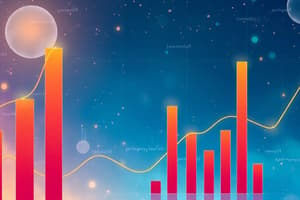Podcast
Questions and Answers
What is the purpose of a confidence interval in statistics?
What is the purpose of a confidence interval in statistics?
A confidence interval provides a range of plausible values for a population parameter based on sample data and reflects the uncertainty in estimates.
Explain how correlation analysis differs from regression analysis.
Explain how correlation analysis differs from regression analysis.
Correlation analysis measures the strength and direction of a linear relationship between two variables, while regression analysis models the relationship between a dependent variable and one or more independent variables.
Name two common methods for collecting data and briefly describe them.
Name two common methods for collecting data and briefly describe them.
Surveys involve gathering data from a sample of individuals, and experiments are controlled investigations to study cause-and-effect relationships.
How does statistical software enhance the analysis of data?
How does statistical software enhance the analysis of data?
What does a wider confidence interval indicate about uncertainty?
What does a wider confidence interval indicate about uncertainty?
What are the three main measures of central tendency in statistics?
What are the three main measures of central tendency in statistics?
Explain the difference between categorical and numerical variables.
Explain the difference between categorical and numerical variables.
What does a p-value indicate in hypothesis testing?
What does a p-value indicate in hypothesis testing?
What are confidence intervals used for in inferential statistics?
What are confidence intervals used for in inferential statistics?
List two common sampling methods and explain how they differ.
List two common sampling methods and explain how they differ.
Define skewness and its relevance in descriptive statistics.
Define skewness and its relevance in descriptive statistics.
How does the multiplication rule apply to independent events in probability?
How does the multiplication rule apply to independent events in probability?
What is the purpose of using ANOVA in inferential statistics?
What is the purpose of using ANOVA in inferential statistics?
Flashcards
Descriptive Statistics
Descriptive Statistics
Methods that summarize key features of a dataset, like central tendency (mean, median, mode), dispersion (range, variance, standard deviation), and shape (skewness, kurtosis). These measures help understand the distribution and characteristics of the data.
Inferential Statistics
Inferential Statistics
Methods that use sample data to make inferences or predictions about a larger population. Key techniques involve hypothesis testing and confidence intervals to determine whether relationships observed in a sample are likely to exist in the population.
Probability
Probability
A framework for quantifying the likelihood of events occurring. It ranges from 0 (impossible) to 1 (certain). Fundamental rules include addition rule (for mutually exclusive events) and multiplication rule (for independent events).
Variable
Variable
Signup and view all the flashcards
Sampling Methods
Sampling Methods
Signup and view all the flashcards
Hypothesis Testing
Hypothesis Testing
Signup and view all the flashcards
Confidence Interval
Confidence Interval
Signup and view all the flashcards
Correlation
Correlation
Signup and view all the flashcards
Regression Analysis
Regression Analysis
Signup and view all the flashcards
Data Collection Methods
Data Collection Methods
Signup and view all the flashcards
Statistical Software
Statistical Software
Signup and view all the flashcards
What is the Mean?
What is the Mean?
Signup and view all the flashcards
What is the Standard Deviation?
What is the Standard Deviation?
Signup and view all the flashcards
What is a Hypothesis?
What is a Hypothesis?
Signup and view all the flashcards
What is a p-value?
What is a p-value?
Signup and view all the flashcards
What is sampling?
What is sampling?
Signup and view all the flashcards
What are Categorical Variables?
What are Categorical Variables?
Signup and view all the flashcards
What are Numerical Variables?
What are Numerical Variables?
Signup and view all the flashcards
What is the Multiplication Rule?
What is the Multiplication Rule?
Signup and view all the flashcards
Study Notes
Descriptive Statistics
- Descriptive statistics summarize and describe the main features of a dataset.
- Common measures include:
- Measures of central tendency (mean, median, mode)
- Measures of dispersion (range, variance, standard deviation)
- Measures of shape (skewness, kurtosis)
- These measures help to understand the distribution and characteristics of the data. Data visualization (histograms, box plots) aids in interpreting these summaries.
Inferential Statistics
- Inferential statistics use sample data to make inferences or predictions about a larger population.
- Key methods include hypothesis testing and confidence intervals.
- Techniques like t-tests, ANOVA, and regression analysis are used to determine whether observed relationships in a sample are likely to exist in the population.
- Inferential statistics rely on statistical models to quantify uncertainty in estimates.
- It addresses broader questions about relationships in populations by leveraging the sample.
Probability
- Probability provides a framework for quantifying the likelihood of an event occurring.
- Probability ranges from 0 (impossible event) to 1 (certain event).
- Basic probability rules:
- Addition rule (for mutually exclusive events)
- Multiplication rule (for independent events)
- Concepts like conditional probability and Bayes' Theorem are fundamental to inferential statistics and modeling uncertainty.
Variables
- Variables are characteristics or attributes that can take on different values.
- Categorical (nominal, ordinal) variables represent categories or rankings.
- Numerical (discrete, continuous) variables represent quantities.
- Understanding the type of variable is essential for selecting appropriate statistical methods.
Sampling Methods
- Sampling involves selecting a subset of a population to make inferences about the whole.
- Different types of sampling methods:
- Simple random sampling, stratified sampling, cluster sampling, systematic sampling.
- Each method has different advantages and disadvantages, impacting the representativeness and accuracy of results.
Hypothesis Testing
- Hypothesis testing is a formal procedure for evaluating claims about a population based on sample data.
- It involves:
- Formulating a null hypothesis and an alternative hypothesis.
- Choosing a significance level (alpha).
- Calculating a test statistic.
- Determining a p-value.
- Making a decision to reject or fail to reject the null hypothesis.
- The goal is to determine if there is enough evidence in the sample to conclude that the null hypothesis is wrong.
Confidence Intervals
- Confidence intervals provide a range of plausible values for a population parameter based on sample data.
- It reflects the uncertainty in estimates.
- A confidence level expresses the certainty that the interval contains the true population parameter.
- Wider intervals indicate higher uncertainty.
Correlation and Regression
- Correlation analysis measures the strength and direction of a linear association between two variables.
- Regression analysis models the relationship between a dependent variable and one or more independent variables.
- Different types of regression include linear, logistic, and polynomial.
- Statistical methods allow for modeling trends and relationships to make predictions.
Data Collection
- Methods for collecting data vary widely based on the study's goals.
- Common types include:
- Surveys: Gathering data from a sample of individuals.
- Experiments: Controlled investigations to study cause-and-effect relationships.
- Observational studies: Observing phenomena without manipulating variables.
- Appropriate data collection techniques are essential for valid and reliable results.
Statistical Software
- Software such as SPSS, R, SAS, and others are widely used to perform statistical analyses.
- These programs facilitate data manipulation, analysis, and visualization.
- Tools provide essential functions for hypothesis testing, regression, and other methodologies.
Studying That Suits You
Use AI to generate personalized quizzes and flashcards to suit your learning preferences.
Description
This quiz covers key concepts in descriptive and inferential statistics. You will explore measures of central tendency, dispersion, and the methods used to make predictions about larger populations through sample analysis. Enhance your understanding of statistical summaries and inferential techniques.




